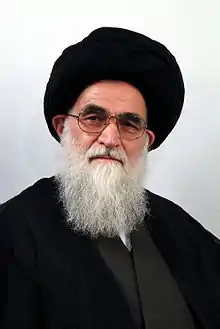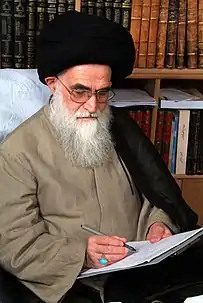Mohammad Sadeq Rouhani
Grand Ayatollah Sayyid Muhammad-Sadiq Husayni Rohani (Persian: محمد صادق حسینی روحانی; b. 1926) is an Iranian Shia marja'.[1]
Muhammad-Sadiq Rohani | |
|---|---|
سيد محمد صادق حسينى روحانی | |
 | |
| Title | Grand Ayatollah |
| Personal | |
| Born | July 16, 1926 |
| Religion | Usuli Twelver Shia Islam |
| Parents | Mahmoud Rohani (father) |
| Relatives | Mohammed Rohani (brother) |
| Senior posting | |
| Based in | Qom, Iran |
| Period in office | 1961–Present |
| Predecessor | Hossein Borujerdi |
| Website | http://www.rohani.ir/ |
Rohani currently resides in Qom. He claims to have gained ijtihad from the grand Ayatollah Abu al-Qasim al-Khoei, at the age of 15. He announced his marja'iyya after the death of grand Ayatollah Hossein Borujerdi, at the age of 35.[2]
Rohani was one of the first senior clerics to be placed under house arrest under direct order from grand Ayatollah Ruhollah Khomeini just a few years after the Iranian revolution.[3] Rohani remains a critic of the Iranian government today.[4]
Early life and education

Rohani was born to Sayyid Mahmoud Rohani (d. 1961), a renowned teacher in the Islamic seminary of Qom. It is believed that his father, was the person who convinced Sheikh Abd al-Karim al-Haeri to move to the city of Qom and establish the seminary there. His mother was the daughter of Sayyid Ahmed Tabatabei Qomi, a Imam of the Fatima Masumeh Shrine.[2] His brother, Muhammad Rohani (d. 1997), was also a grand Ayatollah.[5]
Education
He started his religious education at the young age of four. He complete his muqadamat (introductory studies) by ten, and moved to Najaf. He studied in Najaf for sixteen years and returned to Qom in 1950. When he entered Qom, he began teaching jurisprudence and principles of jurisprudence in the courtyard of the Masumeh shrine. Some of his prominent teachers include, Sheikh Kadhim al-Shirazi, Sheikh Muhammad-Husayn al-Isfahani, Sheikh Muhammad-Ali al-Kadhimi, Sayyid Abu al-Hasan al-Isfahani and Sayyid al-Khoei.[2]
Relationship with al-Khoei
al-Milani has been reported to be very close with al-Khoei, and studied under him for fifteen years.[6] Ayatollah Zadeh Milani has said “al-Khoei once said to my father Ayatollah al-Milani: I take pride in the Islamic Seminary in which an eleven year old studies alongside the elder students and learned scholars, and with reads makaseb (a compilation by Morteza Ansari that is taught in Islamic seminaries) and understands the contents better than them and further analyses it”. The eleven year old he refers to is Rohani.[2]
Rohani also claims to own a letter written by al-Khoei praising him whilst he was at the age of fifteen.[2]
Relationship with the Islamic Republic
At first, Rohani, like most other conservative clerics, was with the Islamic Revolution. In fact, in 1975, Rohani stood by Khomeini and condemned the Rastakhiz party, by issuing a fatwa against the party.[7] In 1980, he warned the ruler of Bahrain to govern in conformance with Islamic principles or face popular overthrow, and then later stood with the Iranian backed revolution in Bahrain, lead by Hadi al-Modarresi, stating "Iran may claim Bahrain again if Iraq continues claiming the three islands in the Gulf."[8]
Rohani was one of the first senior clerics to be placed under house arrest under a direct order from Ayatollah Khomeini just a few years after the Iranian revolution.
In the year 1985, Hussein-Ali Montazeri was selected as the Supreme Leader by the Assembly of Experts, to which Rohani objected and said "the supreme religious leader of an Islamic state should not be selected by an assembly of other clerics, but rather chosen by divine powers." Rohani was so angry at the selection of Montazeri that he publicly declared Khomeini's government un-Islamic, armed security forces immediately attacked his house in the middle of the night and he was put under house arrest for 15 years.
Rohani's Hajj Mollah Sadegh School in Qom was confiscated by the state after he was put under house arrest in 1995. His home was attacked again in 1995 after he had published a letter to President Rafsanjani in which he openly criticized certain governmental policies. His books and parts of his writing were confiscated and his youngest son, Javad, arrested and later sentenced to three years imprisonment. Furthermore, Rohani was pledged “not to continue as ‘Source of Emulation’ for his seven million followers and not to have any visitors.”
After the fall of Saddam Hussein, Rohani attempted to relocate to Iraq but has been barred from leaving the country. His brother Muhammad was arrested in 1994 for insisting that the role of the clergy should be a social, not a political one and criticizing the regime for discrediting Islam.[9] Muhammad died in 1997. A third brother, Mehdi Rohani, died in Paris in 2000.
Rohani claims that Ali Khamenei has repeatedly tried to meet him but he has always refused.[4]
Works

Rohani owns a large library of publications of his own. His most renowned work is Fiqh al-Sadiq (Jurisprudence of al-Sadiq) which comes in 41 volumes. Other books include:[4]
- Zobdat al-Usool (The Essence of Principles of Jurisprudence), 6 volumes.
- Minhaj al-Fuqaha (The Way of the Jurists), 6 volumes.
- al-Masa’il al-Mostahdetha (Renewed Islamic Questions)
- Ta’liq Minhaj al-Salihin (Commentary on Minhaj al-Salihin), 3 volumes.
- Ta’liq 'Urwat al-Wuthqa (Commentary on Urwat al-Wuthqa), 2 volumes.
- al-Jabr wa al-Ikhtiyar (Coercion and Freedom)
- Manasik al-Hajj (Hajj Rituals)
- al-Masa’il al-Montakhiba (Chosen Questions)
- al-Ijtihad wal-Taqleed (Ijtihad and Following)
- Alf Su'al wa Jawab (A Thousand Questions and Answers)
- al-Tahara (Purity)
- Fadha'il Wa Masa'ib Fatima Zahra (Merits and Tragedies of Fatimah)
- Ashura Wa Qiyam al-Imam al-Husayn (Ashura and the Rise of Husayn)
References
- "Biography". Ayatollah Sayyid Muhammad-Sadiq Husayni Rohani's Official website (in Arabic). Retrieved 2020-04-17.
- "Biography". Ayatollah Sayyid Muhammad-Sadiq Husayni Rohani's Official website (in Persian). Retrieved 2020-04-17.
- al-Majallah (in Arabic). al-Sharikah al-Suʻūdīyah lil-Abḥāth wa-al-Taswīq al-Barīṭānīyah. 1997.
- "Visiting Iran's ayatollahs at Qom". BBC News. 2009. Retrieved 2010-01-04.
- "Obituary: Grand Ayatollah Rohani". The Independent. 1997-08-22. Retrieved 2017-08-11.
- al-Shafi'i, Abd al-Malik (2005). Mawqif al-Tashayyu al-Imamiyah Min Baqi Firaq al-Muslimeen [The Stance of Shiism On Other Muslim Sects] (in Arabic). Cairo, Egypt: Maktabat al-Rudhwan. p. 229.
- Hiro, Dilip (2013-09-05). Iran under the Ayatollahs (Routledge Revivals). Routledge. p. 64. ISBN 978-1-135-04381-0.
- Muttam, John (1984-05-01). Arms and insecurity in the Persian Gulf. Radiant. p. 84. ISBN 9780391031579.
- See Mirjam Künkler: "The Special Courts of the Clergy and the Repression of Dissident Clergy in Iran." https://ssrn.com/abstract=1505542
See also
| Wikiquote has quotations related to: Mohammad Sadeq Rouhani |